In the late 1920s, Elmer Keith was not happy with the state of sixgun
cast bullet design, and he was testing some of his ideas for making
them better. After having Belding and Mull make a few moulds for him,
he approached Lyman (Ideal) with his next generation of ideas. He was
working extensively with the .44 Special at this time, so it’s little
surprise that that is where he started. Basically, Keith took the
Heath target bullet (the Ideal 429336, designed by C. E. Heath of the
Boston Pistol Club in 1905) and fattened up the rearward lube groove,
and then converted the forward lube groove to a beveled crimp
groove. The ogive, meplat and overall bearing surface were left
unchanged. Thus was born the first Keith semi-wadcutter (SWC), the
Ideal 429421.
| |
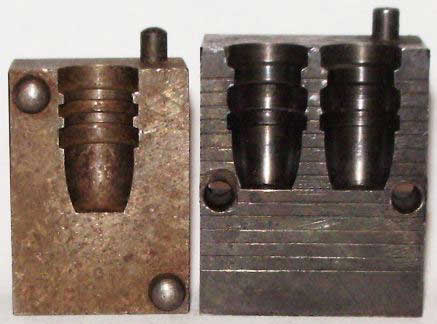 |
|
Left - 429336 / 429421 -
Right |
The 429421
pleased Elmer greatly, and would be his favorite bullet for the next
50 years. The success with the 429421 led him to incorporate similar
design features into cast bullet designs for the .45 ACP (452423), .45
Colt (454424), and .38 Special (358429). His experiences with these
bullets were written up in his 1936 book “Sixgun Cartridges and
Loads”. As he was describing these bullets in his magazine articles of
the late 1920s, he mentioned, almost as an afterthought, that the
“shocking powder” of these bullets could be increased (if so desired)
by adding a hollow-point (HP) cavity. Well, Harold Croft and Captain
Frank Frisbie thought this sounded like a dandy idea and contacted
Ideal to have just such a mould made up for the .38 Special (this was
in the early 1930s, before the .357 Magnum had been introduced). They
talked things over with a Mr. Pickering of Lyman and decided the HP
mould should have a .150” HP cavity, and that it should extend down to
about the crimp groove. The results were, in a word, spectacular.
Croft communicated his results to Keith, and Keith immediately had a
similar HP mould made up for himself. Thus was born the first “Keith
HP” (which Keith didn’t actually design – he designed the original
SWC, and he suggested the HP concept, but the HP was designed by
Pickering, Croft and Frisbie). In 1933 or 1934, this bullet design was
given it’s own cherry number, the Ideal 358439. Testing on Idaho jack
rabbits convinced Elmer that these HP's were a worthwhile addition to
his line of cast bullets, and he quickly had HP moulds made up for his
other SWC designs (which were identified by the original cherry
numbers followed by the “HP” designation). It is worth noting that all
of this was taking place before the introduction of the .357 Magnum,
so all of the development work with the 358439 done by Croft, Frisbie
and Keith was done in the .38 Special cartridge, and mostly in
revolvers (like the .38/44 Heavy Duty and Colt Single Action Army)
whose thicker cylinders allowed the .38 Special cartridge to be loaded
to higher pressures than normal. Higher velocities make for more
violent expansion of a cast HP, and the Ideal 358439 and the .38/44
Heavy Duty go together like a working man’s hand and a well-worn
buckskin glove.
|
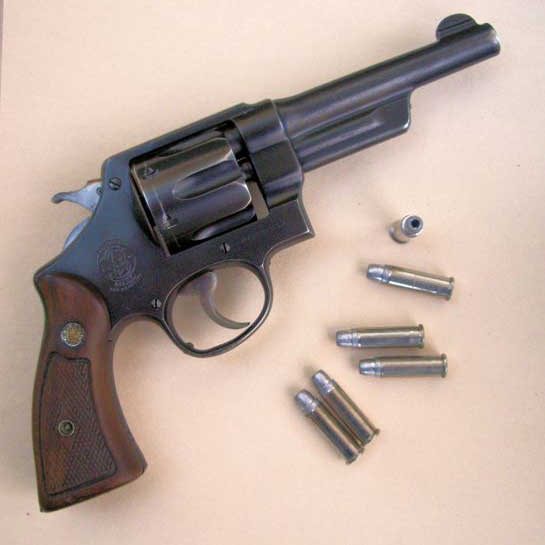 |
|
38-44 Heavy
Duty |
The .357 Magnum
came out in 1935, and the Ideal 358439 had another fine cartridge to
work out of……almost. The S&W .357 Magnum was made with the same
cylinder length of the .38/44 Heavy Duty, and if the 358439 was loaded
into Magnum brass, and crimped in the crimp groove, the overall
cartridge length was too long to function in the relatively short
cylinder. Keith recommended that his bullet either be seated deep in
.357 brass and crimped over the forward driving band, or loaded into
.38 Special cases and crimped in the crimp groove for use in the S&W
N-framed .357 Magnums. Most of the more recent models of .357 Magnum
revolvers have been made with longer cylinders, so this is not an
issue.
Reo Rake was a
former Marine who taught me how to cast bullets back in the 1980s. A
typical Saturday morning would involve him swinging by my duplex, and
me firing up the coffee pot. We would set up the lead pot out on the
back porch (along with a boom box with a healthy supply of a jazz and
blues), and then spend the morning casting whatever bullets either one
of us needed at the time. He would tell me stories about Korea, or
shooting the National Matches at Camp Perry, or about some cute
waitress he met way back when. We would talk about favorite guns –
usually the M1 Garand or the Colt 1911 (he was a 1950s vintage Marine,
after all). We would talk about dream hunts, we would talk about
exotic locations, and we would talk about pretty girls. But mostly, we
just cast a lot of bullets and had one helluva lot of fun. In a lot of
ways, Reo was kind of a crazy uncle who didn’t put a lot of demands on
me, but blessed me with his detailed knowledge of guns, handloading,
and bullet casting. He’s gone now, but I am truly grateful to have
been blessed with him as a friend and a mentor. After all, Reo was the
man who taught me how to cast bullets (and there are times that I
still hear Reo’s jazz when I’m sitting at the lead pot). I miss you
Reo.
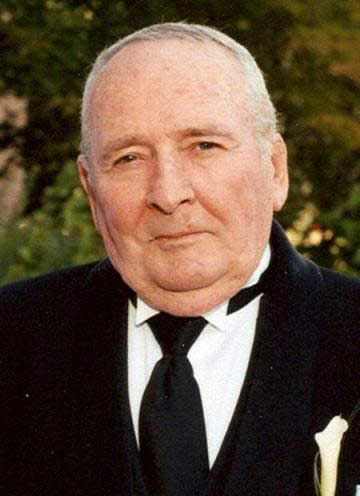 |
|
Reo Rake |
Well, this particular Saturday morning was just like many other
Saturday mornings. I was just finishing up breakfast and was pouring
another cup of coffee when a knock came at the front door. I opened
the door, and there was Reo in his boonie cap, and camo jacket,
smoking his ever-present Marlboro menthol. He had a grin on his face
that would have made any Cheshire cat proud, and he loudly proclaimed,
“Today, you learn how to cast hollow points!”. He smacked a bullet
mould into my hand, and then pushed his way past me to go pour himself
a cup of coffee. That HP bullet mould was an old Ideal 358439. I still
have, and cherish, that old bullet mould.
He spent that Saturday morning explaining to me how cantankerous a HP
mould could be, but that if you learned and understood their foibles,
they would give you bullets that would do things that no other cast
bullet could do. He taught me about casting a little hotter than
normal, and about casting quickly so the HP pins didn’t get a chance
to cool down (“A warm HP pin is a happy HP pin. A cool HP pin makes
bad bullets.”). He taught me not to inspect the HP bullets until after
I was done casting – you don’t want to slow down your casting cadence,
and rejects can go back into the pot just as easily later on as they
can while you’re casting. My first efforts with the old Ideal 358439
were downright ugly, but eventually, with Reo’s tutelage and
encouragement, I got the hang of it and was casting keepers. Time to
work up some loads!
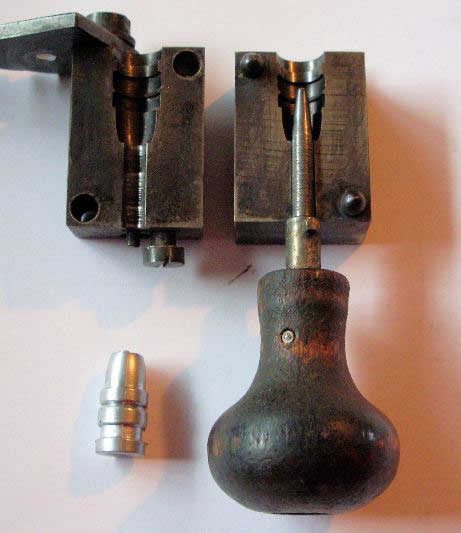 |
|
Ideal 358439 |
I don’t remember what that first .357 Magnum 358439 load was, but I do
remember when my first cast HP hit that first varmint and the
impression it made on me. Ground squirrels, prairie dogs, jack rabbits
-- the result was all the same -- explosive. Nothing like I had ever
gotten from cast bullets before (or most jacketed bullets, outside of
the .357 125 grain JHP's for that matter), and that one bullet mould
could give me a lifetime supply of these bullets! Over the last 25+
years, I have shot countless thousands of the 358439 out of the .38
Special and .357 Magnum, and it continues to impress me with its
accuracy and its performance, and it remains one of my all-time
favorite cast bullets.
For many years, I sized all cast bullets for my .38s and .357s to
.358”. A while back, I did some systematic accuracy testing in my .38
Special and .357 Magnum revolvers and found that .357” cast bullets
gave better accuracy in my guns, across the board. Since then, I have
sized all my .38 Special and .357 Magnum cast bullets .357”. For lube,
I use the homemade Moly lube that I have used for 20+ years (50/50
beeswax/Moly grease), with excellent accuracy and no leading.
The Ideal 358439 drops from the blocks at about 154 grains (depending
on the alloy used). For standard .38 Special loads, there are three
loads that I tend to gravitate towards for cast bullets in this weight
range – 4.2 grains of Bullseye, 4.6 grains of Winchester 231, or 5.0
grains of Unique. All three of these loads will deliver excellent
accuracy, and right around 900 fps from my pet 6” K-38 Target
Masterpiece. When cast very soft (e.g. 30-to-1), the 358439 will
expand at these velocities.
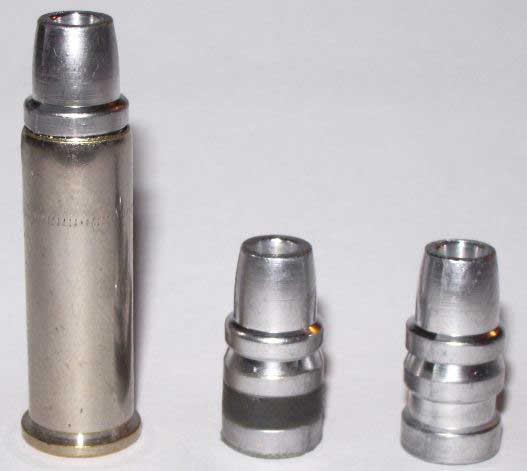 |
|
38 Special and 358439 |
For .38 Special +P loads, I like to load the 358439 over 8.5 grains of
HS-7. According to the 26th Edition of the Hodgdon loading
manual, this combination generates approximately 19,000 CUP peak
pressure, which means it is safe to shoot in any of my post-World War
II K-38s (or stronger guns) (my pre-World War I M&Ps get pampered with
kinder and gentler loads). 8.5 grains of HS-7 underneath the 358439
generates right at 1050 fps from a 6” K-38 and makes an excellent
general purpose varmint load. I generally cast these from recovered
range scrap, with a BHN of roughly 8, and they expand just fine at
these velocities. Hodgdon has dropped HS-7 from production, which is a
shame because it is a superb powder for such +P handgun applications,
but I will continue to assemble and shoot this fine load until I’ve
exhausted my supply (or Hodgdon sees the light and re-introduces
HS-7).
For .357 Magnum, and cast bullets in this weight range, I settled on
14.0 grains of 2400 a long time ago. With the Ideal 358439, this
gives me about 1350 fps (depending on barrel length), excellent
accuracy, zero leading, and truly explosive terminal performance. This
is an outstanding varmint load, and one that will “reach out” on
longer shots with surprising authority.
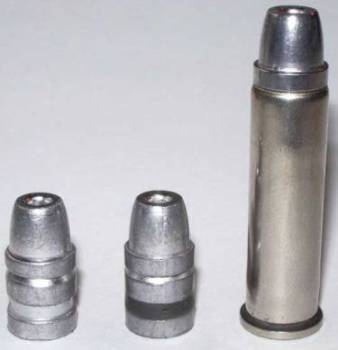 |
|
357 Mag and Cramer #11 |
A single cavity HP mould produces some mighty fine hunting bullets,
but the casting rate can be kind of slow. High volume casting it is
not. In the past, I would handle this by using solid SWC's for
practice and plinking, and saving the HP's for actual hunting
trips. While this approach works, it’s not very satisfying when one
wants to practice at different ranges with the actual HP hunting load,
or when one wants to do some side-by-side expansion testing
comparisons, or stage a few demonstrations for new shooters. No, I was
definitely interested in coming up with a way to do some higher volume
HP casting. The first step I took in this direction was a number of
years ago when I bought a Cramer #11 2-cavity HP mould online. The
Cramer HP design holds the HP pin captive with two transverse pins
that go through one of the mould blocks, so there are no separate
steps for removing the HP pin and then putting it back in place.
Simply cast, strike the sprue, invert the mould over the “drop zone”,
open the mould and the bullets drop free. Close the mould and repeat.
Casting cadence with a Cramer 2-cavity HP mould is almost as fast as
with a regular 2-cavity mould, meaning that one can generate a decent
pile of bullets in fairly short order. While the 158 grain Cramer #11
HP is not an exact duplicate of the 358439 (the nose is a little
shorter, and the HP cavity isn’t quite as wide or as deep), it is
similar in terms of concept, design, accuracy and terminal
performance. I like the Cramer #11 HP.
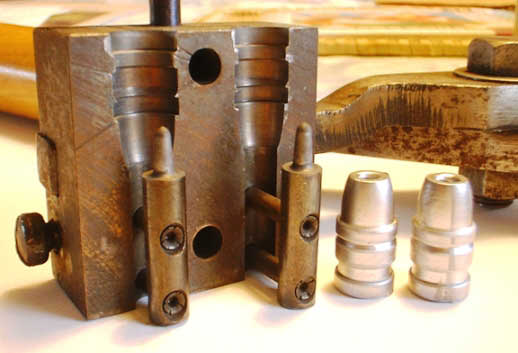 |
|
Cramer #11 2 cavity HP |
But the Cramer #11 HP just isn’t the Ideal 358439, and while it’s a
very good bullet, sometimes only the original will do. Erik Ohlen at
Hollow Point Bullet Mold Service
offers a
service where he will convert a customer’s mould to drop HP
bullets. Erik has modified a number of moulds for me over the years,
and has done an excellent job every time. One of the innovations that
Erik has introduced is the “inset bar” conversion, in which one or
more HP pins are held captive in a single inset bar that in turn is
held captive inside the mould. I have had Erik do this conversion for
me on both 2-cavity and 4-cavity moulds in the past, and I have been
very impressed with both the design and the execution. This is a very
rugged design and it allows the bullet caster to cast a bunch of HP's
in a short period of time (I can generally maintain a rate of ~600
HP/hour with the 4-cavity moulds). I happened across a used Lyman
4-cavity 358429 mould at a reasonable price, and the wheels started
turning. Erik and I discussed this project over the phone and
eventually we decided to go with .150” cavities, 7 degree taper,
rounded tips, etc.
(http://www.hollowpointmold.comm/,
or email @
erik@hollowpointmold.com,
(541) 738-2479)
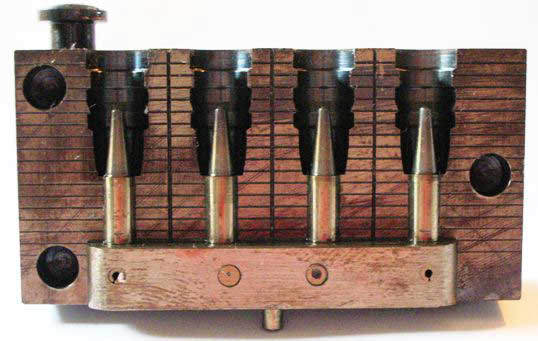 |
|
Ohlen 4 cavity 358429 HP |
When the mould came back, I was very pleased with what I saw. I fired
up the lead pot right away and loaded it up with 9 lbs of recovered
range scrap (BHN about 8). I pre-heated the mould on the back
shelf of the lead pot as the lead was melting. I had a few rejects on
the first few pours, but that quickly ended after the pins got warmed
up, then the mould started casting smoothly and without any problems.
Recycling the sprues as I went, I started casting at a comfortable
pace. 40 minutes later, the pot was empty, and I had over 400 HPs to
play with. They average about 153 grains and shoot very well indeed. I really like this mould! Now I can produce the 358439 in bulk, and
shoot as many as I like. I think Keith, Croft and Captain Frisbie
would approve of this innovation. |